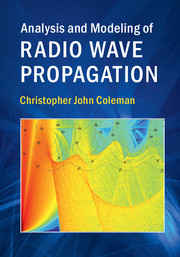Book contents
- Frontmatter
- Contents
- Preface
- 1 Basic Concepts
- 2 The Fundamentals of Electromagnetic Waves
- 3 The Reciprocity, Compensation and Extinction Theorems
- 4 The Effect of Obstructions on Radio Wave Propagation
- 5 Geometric Optics
- 6 Propagation through Irregular Media
- 7 The Approximate Solution of Maxwell's Equations
- 8 Propagation in the Ionospheric Duct
- 9 Propagation in the Lower Atmosphere
- 10 Transionospheric Propagation and Scintillation
- Appendix A Some Useful Mathematics
- Appendix B Numerical Methods
- Appendix C Variational Calculus
- Appendix D The Fourier Transform
- Appendix E Finding Stationary Values
- Appendix F Stratified Media
- Appendix G Useful Information
- Appendix H A Perfectly Matched Layer
- Appendix I Equations for TE and TM Fields
- Appendix J Canonical Solutions
- Index
1 - Basic Concepts
Published online by Cambridge University Press: 19 January 2017
- Frontmatter
- Contents
- Preface
- 1 Basic Concepts
- 2 The Fundamentals of Electromagnetic Waves
- 3 The Reciprocity, Compensation and Extinction Theorems
- 4 The Effect of Obstructions on Radio Wave Propagation
- 5 Geometric Optics
- 6 Propagation through Irregular Media
- 7 The Approximate Solution of Maxwell's Equations
- 8 Propagation in the Ionospheric Duct
- 9 Propagation in the Lower Atmosphere
- 10 Transionospheric Propagation and Scintillation
- Appendix A Some Useful Mathematics
- Appendix B Numerical Methods
- Appendix C Variational Calculus
- Appendix D The Fourier Transform
- Appendix E Finding Stationary Values
- Appendix F Stratified Media
- Appendix G Useful Information
- Appendix H A Perfectly Matched Layer
- Appendix I Equations for TE and TM Fields
- Appendix J Canonical Solutions
- Index
Summary
This chapter introduces the fundamental ideas of radio waves and radio systems. It is designed to give a brief introduction to radio technology for those without a background in this area. The chapter includes an introduction to a variety of propagation phenomena as a motivation for the more detailed analysis in later chapters.
Waves
The concept of a wave is something for which it is very difficult to find a clear definition in the literature. Before proceeding, however, it is important that we have a good understanding of what we mean by a wave. In this regard, it is instructive to start with the surface water wave, a phenomenon that gives us one of the best practical illustrations of wave phenomena in general. Water waves are something that most of us have experienced and that exhibit many of the important features of waves and their propagation. As children, we have nearly all generated waves by throwing stones into a pond. Before the stone lands, the surface of the pond (the propagation medium) is calm. After impact, however, there is a ripple that travels radially outward from the point of impact. The ripple forms a circular band of disturbance that expands at a finite speed. Within the band the ripple maintains its shape but with amplitude that reduces as the radius of the band increases. As the ripple travels outward, it might encounter a floating object and then cause it to bob up and down. This motion can be used to extract energy from the wave, energy that was originally supplied by the stone's impact (the wave source). Further, the vertical motion of the object provides a means of detecting the passage of a wave.
Water waves illustrate several important features that are common to all wave phenomena. First, the wave can transport energy from one point (the source) to another (the detector), the energy being transported at a finite speed. Second, after the passage of the wave, the medium returns to its undisturbed state. This last point leads on to another important property of wave phenomena, the ability to make arbitrarily shaped waves. Instead of causing the wave by casting a single stone, we could simply drive the water up and down in an arbitrary fashion (by a sequence of impacts of varying force).
- Type
- Chapter
- Information
- Analysis and Modeling of Radio Wave Propagation , pp. 1 - 14Publisher: Cambridge University PressPrint publication year: 2017



